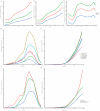The burden of vision loss due to cataract in China: findings from the Global Burden of Disease Study 2019
- PMID: 37853108
- PMCID: PMC10965953
- DOI: 10.1038/s41433-023-02798-0
The burden of vision loss due to cataract in China: findings from the Global Burden of Disease Study 2019
Abstract
Objective: To provide a reference for future policy and measure formulation by conducting a detailed analysis of the burden of vision loss due to cataract by year, age, and gender in China from 1990 to 2019.
Methods: Data on the prevalence and disability-adjusted life-years (DALYs) due to cataract in China and neighboring and other G20 countries were extracted from the 2019 Global Burden of Disease (GBD) study to observe the changing trends of vision loss.
Results: The number and rate of all-age prevalence and DALYs for cataract in China increased significantly from 1990 to 2019. The age-standardized DALYs rate witnessed a slowly declining trend by 10.16%. And the age-standardized prevalence increased by 14.35% over the 30-year period. Higher prevalence and DALYs were observed in female population from 1990 through 2019, with little improvement over the decades(all p < 0.001). The disease burden of cataract is higher in middle-aged and elderly people. Blindness accounted for the largest proportion of vision impairment burden caused by cataract in China. The age-standardized prevalence and DALY rate of cataract in China were lower than those in India and Pakistan, but higher than those in Russia, South Korea, North Korea, Singapore, and Japan.
Conclusions: In the past 30 years, although the age-standardized DALYs rate has decreased slightly in China, the all-age prevalence and DALYs have both increased. This study highlights the importance of reducing cataract burden by providing timely and easily accessible quality care, especially in females and the elderly population.
© 2023. The Author(s), under exclusive licence to The Royal College of Ophthalmologists.
Conflict of interest statement
The authors declare no competing interests.
Figures




References
MeSH terms
LinkOut - more resources
Full Text Sources
Medical
Miscellaneous

